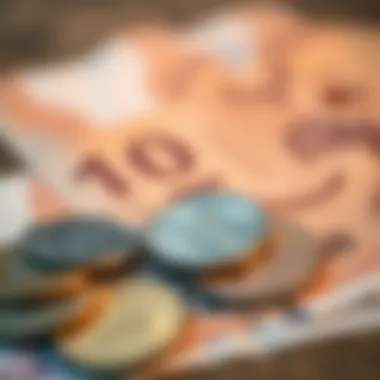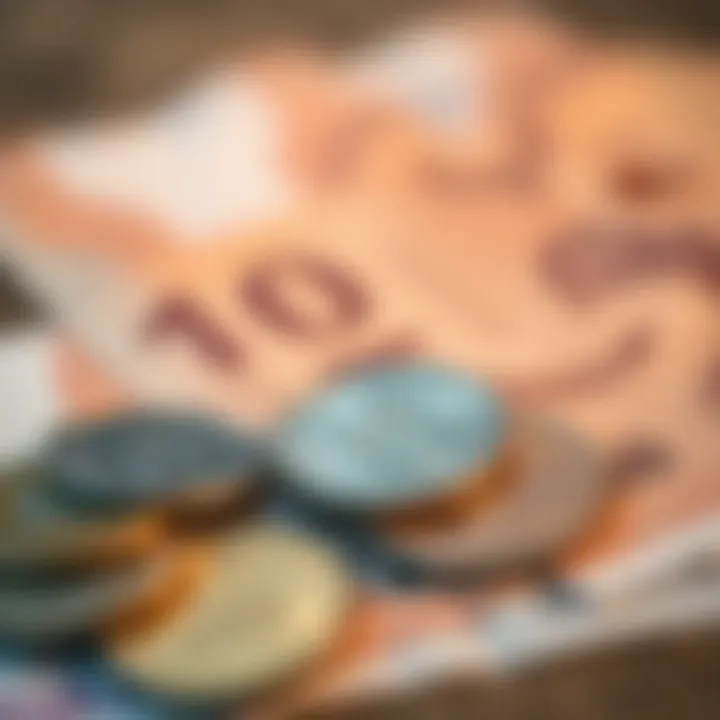Exploring the Dirham: Dubai's Currency Insights
Intro
When one thinks of Dubai, images of towering skyscrapers and luxurious lifestyles often come to mind. However, beneath the glitz and glamour lies an intricate financial system anchored by its currency, the United Arab Emirates Dirham (AED). This article sets out to provide a thorough understanding of the Dirham's role not only as a medium of exchange but also as a key player in the investment landscape, particularly within the bustling real estate market of Dubai.
The UAE Dirham has a rich history, starting off in the early 1970s when it replaced the Qatar and Dubai Riyal, driven by the unification of the seven emirates into what we now know as the United Arab Emirates. Over the years, it has evolved alongside Dubai's rapid development into a global hub for tourism and business. Understanding the nuances of how this currency operates—its exchange rates, historical significance, and current trends in the local economy—is crucial for investors, realtors, developers, and renters looking to make informed decisions.
Given how important currency stability is for long-term investments, particularly in real estate, we will delve into market analysis, investment opportunities, and the overall economic environment affected by the currency's performance. As the Dirham continues to play an integral role in Dubai's financial framework, having a solid grasp of its implications is vital for navigating this vibrant city.
Preface to the Currency of Dubai
When we think about Dubai, it's easy to get dazzled by skyscrapers and lavish lifestyles. However, the currency that powers this economic engine is often overlooked, yet it plays a crucial role in shaping the city's financial landscape. The currency of Dubai, known as the UAE Dirham, is a linchpin in all economic transactions, whether for daily purchases or real estate deals. A solid understanding of this currency is essential for investors, realtors, and anyone engaging in the dynamic marketplace of this city.
Defining the Currency
At its core, the UAE Dirham is more than just a medium of exchange. Established in the early 1970s, it is pegged to the US dollar, creating a stable environment for trade and investment. This stability underpins confidence among foreign investors and residents. The symbol used for the Dirham is DH or د.إ. in Arabic.
The importance of defining the Dirham lies in the fact that it serves as a measure of value, enabling transactions that range from your morning coffee to multi-million dollar property deals. Without this common unit, the intricacies of trade and business would be almost insurmountable.
Significance of Currency in Economic Transactions
Understanding the significance of currency in Dubai’s economic framework is like peering through a keyhole to a larger world. When people engage in transactions, they are not just trading goods or services but are participating in an intricate web of economic activity.
Consider the following points regarding the currency's role in economic transactions:
- Facilitation of Trade: The Dirham allows businesses to price goods and services in a standardized way, ensuring comparability and clarity for both buyers and sellers.
- Investment Magnet: A stable currency attracts foreign investments. Investors feel safe putting their money into developments or businesses when they know the value of their investments won't erode overnight.
- Consumer Confidence: For residents and tourists, the assurance that currency remains stable builds confidence to spend. This translates into thriving retail markets and bustling restaurants.
- Global Trade Integration: With its pegged status to the US dollar, the Dirham allows for relatively seamless international transactions, promoting Dubai as a global business hub.
"A strong and stable currency is the backbone of economic prosperity, and the UAE Dirham exemplifies this principle in Dubai’s context."
In summary, grasping the essence of the UAE Dirham sets the stage for a more informed discussion about its historical development, current structure, and future potential. Understanding currency affects not just financial transactions but ultimately influences all aspects of life in Dubai, making it a theme worth diving deeper into.
Historical Development of the Dirham
The evolution of the Dirham is not just a testament to economic growth but is deeply woven into the cultural and historical fabric of the United Arab Emirates. Grasping the historical development of the Dirham grants a clearer view of how this currency influences modern economic activities and serves as a bridge connecting ancient trade systems to today's global economy. In this section, we will explore the origins of the Dirham and the significant shift from a barter-based economy to the currency-based one we recognize now.
Origins of the United Arab Emirates Dirham
The UAE Dirham, introduced in 1973, represents a pivotal moment in the financial landscape of the Emirates. Its name, "Dirham", traces back to the Greek word 'drachma', which itself has ancient roots in trade practices across various civilizations. Prior to the Dirham’s adoption, the region relied heavily on various forms of barter, as well as foreign currencies, notably the Indian Rupee and the British Pound.
In the early days, trade was informal; items exchanged ranged from spices to precious metals. Merchants operated under a system of trust and negotiation, with values often fluctuating based on necessity rather than a fixed standard. This lack of a standardized currency often led to confusion and inconsistency, hindering trade between different groups.
The emergence of the Dirham not only standardized transactions within the UAE but also aligned the nation's economy with international trading practices. It helped to formalize economic interactions, constructing a framework where businesses could thrive without the ambiguity of fluctuating values. The introduction of this currency was, in every sense, a leap into modernity, paving the way for future economic aspirations.
Transition from Trade and Barter to Currency Economy
The shift from a barter system to a currency-based economy is a narrative filled with challenges and innovations. Initially, the barter system thrived in the UAE, where goods and services exchanged were a matter of immediate need and availability. However, as trade expanded, the limitations of bartering became glaringly apparent. Differing valuations and the perishability of goods often meant that trading was far more complicated than it needed to be.


Benefits of transitioning to a currency economy include:
- Standardization of Value: Fixed denominations streamlined transactions, allowing for clearer assessments of worth.
- Ease of Trade: The ability to trade using Dirhams simplified negotiations and enabled more complex economic structures.
- Investment Opportunities: With a reliable currency, both local and foreign investors found it simpler to invest in businesses and properties, vital for economic growth.
The transition wasn't without its challenges. Resistance came from traditional merchants accustomed to established bartering systems, and the initial rollout of the Dirham met with some skepticism from the public. However, as the nation prospered and the benefits became crystal clear, acceptance grew. Over time, the Dirham has entrenched itself as not just a currency but a symbol of the nation’s economic ambitions and identity.
"The Dirham encapsulates the history of Dubai's trade relations, blending the old with the new and illustrating the evolution of commerce in this vibrant region."
Current Structure of the UAE Dirham
The current structure of the UAE Dirham is a vital aspect to understand for anyone engaging in trade or investment in Dubai. In today's fast-paced economy, being aware of the nuances of the currency can greatly influence financial decisions.
Physical Denominations of the Dirham
The UAE Dirham comes in both coins and notes, with each denomination playing a significant role in daily transactions. Coins are available in 1, 5, 10, 25, 50 fils, and 1 Dirham. These smaller denominations are usually practical for everyday purchases, such as transportation or small food items. Notably, the 1 Dirham coin often sees frequent use among commuters jumping on the metro or grabbing a quick snack at a local café.
The paper notes are issued in larger denominations of 5, 10, 20, 50, 100, 200, 500, and 1000 Dirhams. Each of these notes is designed with unique colors and intricate designs, reflecting the rich cultural heritage of the UAE. For instance, the 100 Dirham note is notable for its depiction of Sheikh Zayed bin Sultan Al Nahyan, symbolizing the guidance and vision pivotal in the UAE's development.
Here's a quick breakdown of the various denominations:
- Coins: 1, 5, 10, 25, 50 fils, and 1 Dirham.
- Notes: 5, 10, 20, 50, 100, 200, 500, and 1000 Dirhams.
Having a mix of both coins and banknotes facilitates smoother transactions while navigating local markets or interacting with service providers.
Features and Security Measures of the Dirham
In the age of increasing counterfeiting risks, the UAE Dirham is equipped with a range of security features that bolster its credibility. Each note incorporates advanced technology to mitigate forgery issues that plague many currencies worldwide. Key features include:
- Watermark: Each note has a distinct watermark that becomes visible when held up to the light, making it an effective deterrent for counterfeiters.
- Color-shifting Ink: Certain denominations employ ink that changes color, providing an additional layer of security that is difficult to reproduce.
- Microprinting: Tiny text is printed on various parts of the notes, only visible under magnification.
- Security Thread: A visible thread runs through the note, enhancing its authenticity.
Investors and residents alike benefit from these security measures. Knowing that the Dirham is safeguarded by sophisticated technology gives a sense of stability and trust in financial dealings.
"Understanding the physical aspects and security of the currency fortifies an informed approach to financial engagement in Dubai."
To wrap it up, the current structure of the UAE Dirham, with its wide range of denominations and robust security measures, is not just about currency; it represents a system that fosters economic growth and trust among both residents and investors. As Dubai continues to establish itself as a financial hub, the Dirham stands as a testament to the nation's commitment to modernizing its economy while retaining a stronghold on its rich cultural legacy.
Exchange Rate Dynamics
Exchange rate dynamics play a crucial role in understanding the financial landscape of Dubai, particularly for investors and businesses engaged in its thriving economy. The UAE Dirham, pegged to the US Dollar, offers a level of stability and predictability in transactions, which is essential for strategic planning in various sectors, including real estate, trade, and tourism. This section explores the nuances of this exchange rate system and the factors that influence it, providing valuable insights for stakeholders navigating this vibrant market.
Understanding Fixed Exchange Rate System
The UAE has established a fixed exchange rate system where the Dirham is pegged to the US Dollar at a rate of approximately 3.67 Dirhams to 1 Dollar. This arrangement provides several benefits that are essential for the economic stability of Dubai:
- Stability: A fixed exchange rate reduces uncertainty in transactions involving foreign currencies, encouraging investment.
- Inflation Control: Maintaining this peg helps stabilize inflation by limiting fluctuations that could arise in a flexible exchange rate regime.
- Trade Benefits: It facilitates trade, making it easier for businesses to plan expenses and revenues when dealing with international partners.


However, reliance on a fixed rate may also present challenges. For example, if the US Dollar strengthens significantly against other currencies, it may make the Dirham more expensive for foreign importers, potentially impacting import levels.
The government closely monitors the exchange rate, maintaining the peg by intervening in the foreign exchange market when necessary, using reserves to ensure that fluctuations remain within acceptable ranges. This kind of system creates an environment of confidence, crucial for both local and foreign investors.
Factors Influencing the Exchange Rate
While the fixed system provides a basic level of stability, several factors can influence the Dirham's status:
- Global Economic Conditions: Changes in global economies significantly impact investor confidence and currency strength. For instance, a global recession can result in capital flight or slower foreign investment.
- Interest Rates: The UAE Central Bank adjusts interest rates which can directly influence inflation and, consequently, the value of the Dirham. Higher interest rates tend to attract foreign capital, boosting demand for the currency.
- Oil Prices: As a significant oil exporter, fluctuations in oil prices heavily influence the overall economic health of the UAE, further impacting the strength of the Dirham.
- Political Stability: The political landscape in the UAE, unlike in some neighboring regions, offers a stable environment that attracts foreign investment, enhancing the Dirham's value.
"The dynamics of a stable currency are pivotal in fostering a thriving economy, and in Dubai, the Dirham's fixed exchange rate ensures that uncertainty is kept at bay."
Understanding these elements provides critical insights into potential risks and opportunities for those involved in Dubai's economic activities. Monitoring the broader economic indicators and geopolitical developments can greatly assist stakeholders in making better financial decisions.
Currency Exchange Methods in Dubai
Currency exchange methods in Dubai play a pivotal role in both the everyday transactions of residents and investors alike. As one of the most bustling and vibrant markets in the world, Dubai offers several avenues for currency exchange that cater to a diverse population, ranging from tourists to long-term residents. Understanding these methods not only facilitates smoother financial dealings but also helps individuals and businesses navigate potential risks and gains in their transactions.
Currency Exchange Services Available
When it comes to exchanging currency in Dubai, several well-established services are at one’s disposal. The options range from traditional banks to specialized exchange houses, each offering distinct advantages.
- Banks: Major banks such as Emirates NBD, Abu Dhabi Commercial Bank, and Dubai Islamic Bank provide currency exchange services. These banks generally offer competitive rates, especially for larger amounts. Banking hours may be limited, so it’s prudent to check in advance.
- Exchange Houses: Programs like Al Ansari Exchange and UAE Exchange are ubiquitous in Dubai. Found in various locations, they often provide better exchange rates than banks and more flexible hours. For those seeking quick transactions, these houses may provide a more convenient option.
- Hotels and Airports: Hotels and international airports have currency exchange counters. While these are convenient for immediate needs, they can charge higher fees and offer less favorable rates. It’s wise to rely on these options only as a last resort for urgent currency needs.
- Online Platforms: As the digital landscape continues to grow, numerous platforms now facilitate currency exchange through mobile applications. Users may find competitive rates and can often place their orders conveniently. However, it’s crucial to ensure that these platforms are well-regulated and secure before proceeding.
"In a city of opportunities, where every Dirham counts, understanding where to exchange currency can mean everything from saving a few coins to making savvy investments."
Digital Currency Exchange Options
The rise of technology has ushered in a new age of currency exchange, particularly in a forward-thinking place like Dubai. Digital currency exchange options have gained traction for their convenience and accessibility. Here are some key considerations:
- Cryptocurrency Exchanges: With digital currencies becoming more mainstream, cryptocurrencies like Bitcoin and Ethereum are traded widely. Platforms such as Binance and BitOasis allow users to convert funds seamlessly into these digital assets. The volatility of cryptocurrencies does pose a risk, so potential investors should remain informed about market trends.
- Mobile Wallets: Services such as Apple Pay, Samsung Pay, and local apps like Wadih or RTA Smart Parking allow users to manage their currencies digitally. These options are efficient for transactions and can enhance privacy. Users can load funds in Dirhams or other currencies, making payments at retail outlets, restaurants, and for services without the need for physical cash.
- Peer-to-Peer Platforms: Platforms that connect individuals for currency exchange, such as LocalBitcoins or local trade groups on social media, allow users to negotiate rates and exchange currencies directly. This method has the potential to yield favorable rates, but it certainly requires the precaution of due diligence to avoid scams.
In summary, Dubai’s currency exchange methods are plentiful and varied, suiting a broad spectrum of users from casual travelers to seasoned investors. Access to efficient services can significantly streamline financial dealings, so understanding both traditional and digital methods proves invaluable in this globally integrated market.
Impact of Currency on Real Estate
The currency of a region, especially in a hub like Dubai, holds significant sway over its real estate sector. Understanding the nuances of how the UAE Dirham operates is crucial for anyone considering investment, buying, or renting property in this dazzling city. Being a stable currency, the Dirham facilitates the smooth flow of transactions, impacting both local residents and foreign investors.
Role of the Dirham in Property Transactions
The UAE Dirham plays a pivotal role in property transactions, acting as the medium through which investments are made. One must consider how its fixed exchange rate to the US dollar creates a sense of stability, which is particularly appealing to foreign investors. This stability reduces the risks associated with currency fluctuations, making Dubai's real estate a more attractive option for those looking to invest in a robust market.
When processing property transactions, the Dirham's value directly influences purchasing power—meaning that any shifts in currency value can either enhance or diminish the buying capacity of potential investors. For instance, a stronger Dirham against foreign currencies can make properties in Dubai appear more expensive to overseas buyers, potentially impacting demand. Conversely, if the Dirham weakens, properties become more attractive to international investors due to lowered costs.
Factors such as inflation and periodic adjustments by the Central Bank of the UAE also play a role, making it vital for investors to keep an eagle eye on economic indicators related to the Dirham. Successful real estate transactions hinge on understanding these dynamics, as they could sway decisions for buyers or sellers alike.


Foreign Investment and Currency Considerations
In recent years, Dubai has positioned itself as a global player in attracting foreign investment, particularly in real estate. For foreign investors, understanding the localized currency environment is crucial. The Dirham's stability often leads to the perception of safety in investments. Additionally, properties priced in Dirhams guard against unpredictable price swings that can occur in more volatile currencies.
Investors often need to consider the following:
- Currency Exchange Costs: Costs can eat into profit margins if not carefully managed, particularly for those converting large sums.
- Tax Implications: Certain nations impose taxes on foreign investments, which can influence the appeal of Dubai real estate.
- Market Entry and Exit Strategies: The movement of the Dirham in the global market determines when it might be advantageous to buy or sell.
Furthermore, differences in currency regulations prompted by both local and international policies may necessitate a deeper understanding of the legal aspects surrounding property investment. Consulting with local real estate experts can provide clarity on how currency fluctuations might affect long-term asset value.
"In a city where high-end property meets diverse cultural influences, having a firm grasp on the local currency's direction can mean the difference between a fruitful investment and one fraught with complications."
In summary, the Dirham's role in Dubai's real estate landscape cannot be overstated. Whether you're an investor, a realtor, or even a renter, recognizing the impact of currency on property transactions and foreign investment considerations will offer a more tailored and informed approach to navigating this vibrant market.
Future Prospects for the Currency of Dubai
As we look ahead to the future, the relevance of currency changes in Dubai cannot be overstated. The United Arab Emirates Dirham (AED) is positioned at a pivotal point, influenced by shifting economic paradigms, technological advancements, and worldwide financial trends. Understanding these factors is vital for investors, realtors, developers, and anyone engaged in Dubai's vibrant economy. A solid grasp of future prospects aids in better decision-making, especially in a market as dynamic as Dubai's.
Potential Economic Impacts of Currency Changes
Economic shifts are often influenced by currency valuation, and Dubai is no exception. Changes in the Dirham will likely echo through several sectors, prompting adaptive strategies. Here are some key points worth considering:
- Investment Flows: A stable or strengthening Dirham could attract more foreign investment, boosting sectors such as real estate and tourism. Conversely, if the Dirham faced depreciation, investors might seek more favorable conditions elsewhere.
- Inflation Pressure: Currency value affects purchasing power. If the Dirham weakens, the citizens could feel the pinch, leading to decreased consumer confidence. Things might get tighter around the dining table, impacting local businesses and overall economic health.
"Currency values are the heartbeat of economies; fluctuations can signal bigger trends."
- Trade Relationships: The Dirham’s strength or weakness can also influence trade dynamics within the Gulf Cooperation Council (GCC) and beyond. For Dubai, which thrives on international trade, this can mean changes in export and import balances, ultimately affecting the country's GDP.
- Cost of Borrowing: A potent Dirham may allow for lower borrowing costs, stimulating more construction, development projects, and perhaps driving housing prices further skyward. On the flip side, if economic instability arises, banks may tighten lending, leading to a slowdown in development.
Integration of Emerging Technologies in Currency Management
The advent of new technologies presents exciting possibilities for the Dirham's future. Embracing these advancements can streamline operations and enhance transparency in financial transactions:
- Blockchain Technology: Utilizing blockchain for currency transactions can ensure greater security and efficiency. Smart contracts could automate agreements and payments, reducing the need for intermediaries and minimizing costs.
- Digital Wallets and Crypto Integration: The rise of digital wallets and cryptocurrencies poses both challenges and opportunities. While there's concern over traditional currencies being overshadowed, Dubai has the potential to integrate these systems, potentially even supporting UAE Dirham-backed stablecoins to ensure stability while providing modern payment solutions.
- AI and Machine Learning: These technologies can facilitate precise currency forecasting and trend analysis. By leveraging big data, stakeholders can make enlightened decisions based on predictive analytics, bolstering investments and economic strategies.
- Fintech Innovations: The financial technology sector is ramping up, creating more accessible and user-friendly currency exchange options. This can empower both residents and tourists, making transactions smoother and fostering a more inviting atmosphere for international business.
Epilogue
Concluding an exploration into the currency of Dubai, particularly the UAE Dirham, is like tying together the loose ends of a complex tapestry. The significance of currency in this vibrant region is not merely about transactions but speaks volumes about its economic landscape. The Dirham stands both as a symbol of stability and a facilitator of growth, weaving through activities from daily purchases to monumental real estate investments.
Summary of Key Points
Reflecting on the discussion, several key points merit reiteration:
- The UAE Dirham is more than just a medium of exchange; it's a cornerstone of economic activity in Dubai, deeply intertwined with trade, investment, and growth.
- Historically, the Dirham evolved from a barter system, marking the transition to a currency-driven economy that supports a burgeoning marketplace.
- Understanding exchange dynamics reveals how the fixed system impacts what investors can expect when entering Dubai's robust market.
- Currency exchange methods have diversified, catering to both digital enthusiasts and traditionalists, offering convenience for residents and visitors alike.
- Investing in Dubai's real estate demands a keen understanding of currency implications, shaping financial strategies for both local and foreign investors.
- Emerging technologies signal a future where currency management may shift towards digital innovations, potentially altering how transactions are perceived.
Given these components, it’s clear that those engaged in Dubai's economic activities—be they investors, realtors, or everyday consumers—must pay close attention to the role of the Dirham.
Final Thoughts on the Role of Currency in Dubai's Economy
The role of currency in Dubai's economy cannot be overstated. The Dirham does not just represent value; it embodies the spirit of Dubai's forward-thinking vision. As this city continues to attract talent and investment from all corners of the globe, understanding the nuances of its currency becomes paramount.
The Dirham's stability boosts investor confidence; when people are reassured that their investments won’t vanish like smoke in the wind, they are more likely to take the plunge. This fostering atmosphere has historically made Dubai a safe harbor for investments, particularly in real estate. Moreover, with digital currency and innovative management practices creeping in, the landscape is set to evolve yet again.
In summary, grasping the implications of currency in Dubai is essential not just for those directly involved but for anyone looking to navigate the shifting waters of this dynamic economy. By committing to an understanding of the Dirham, investors, residents, and business leaders position themselves favorably in a landscape defined by rapid change and boundless opportunities.











